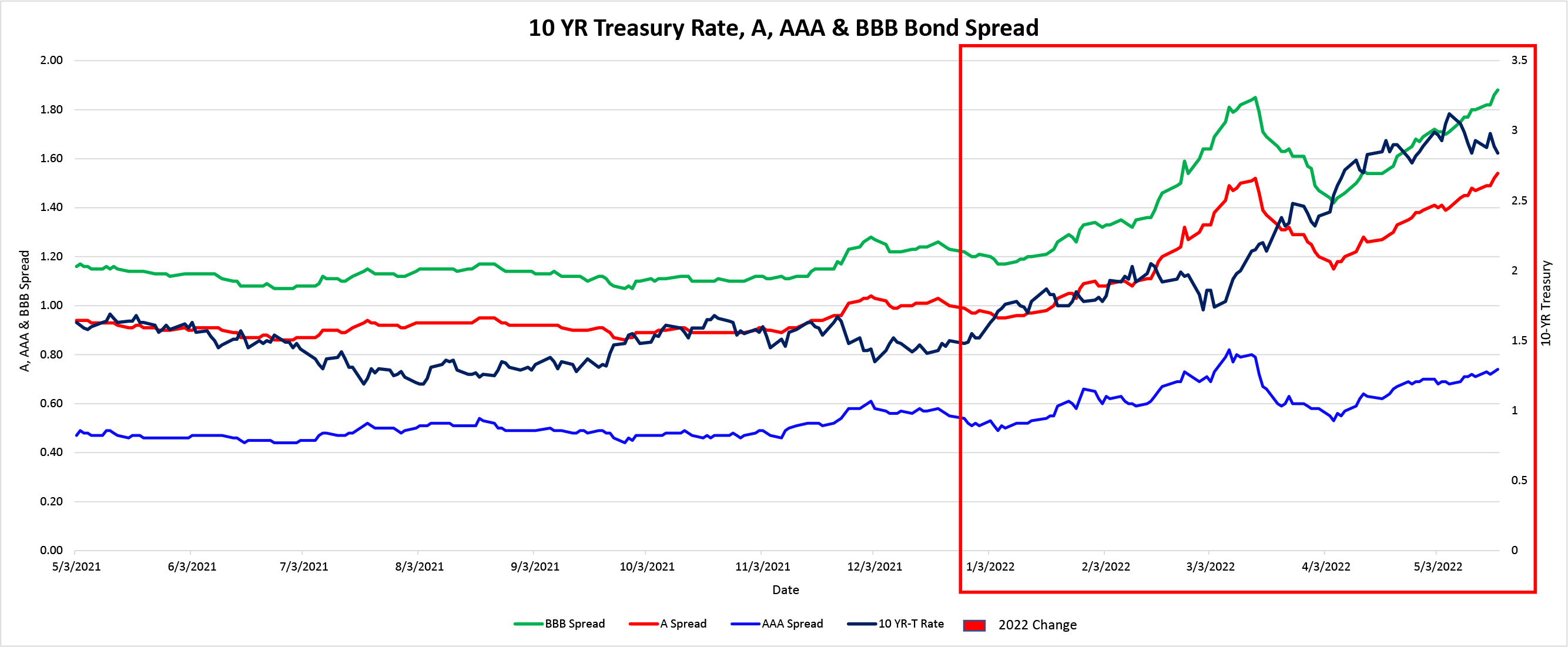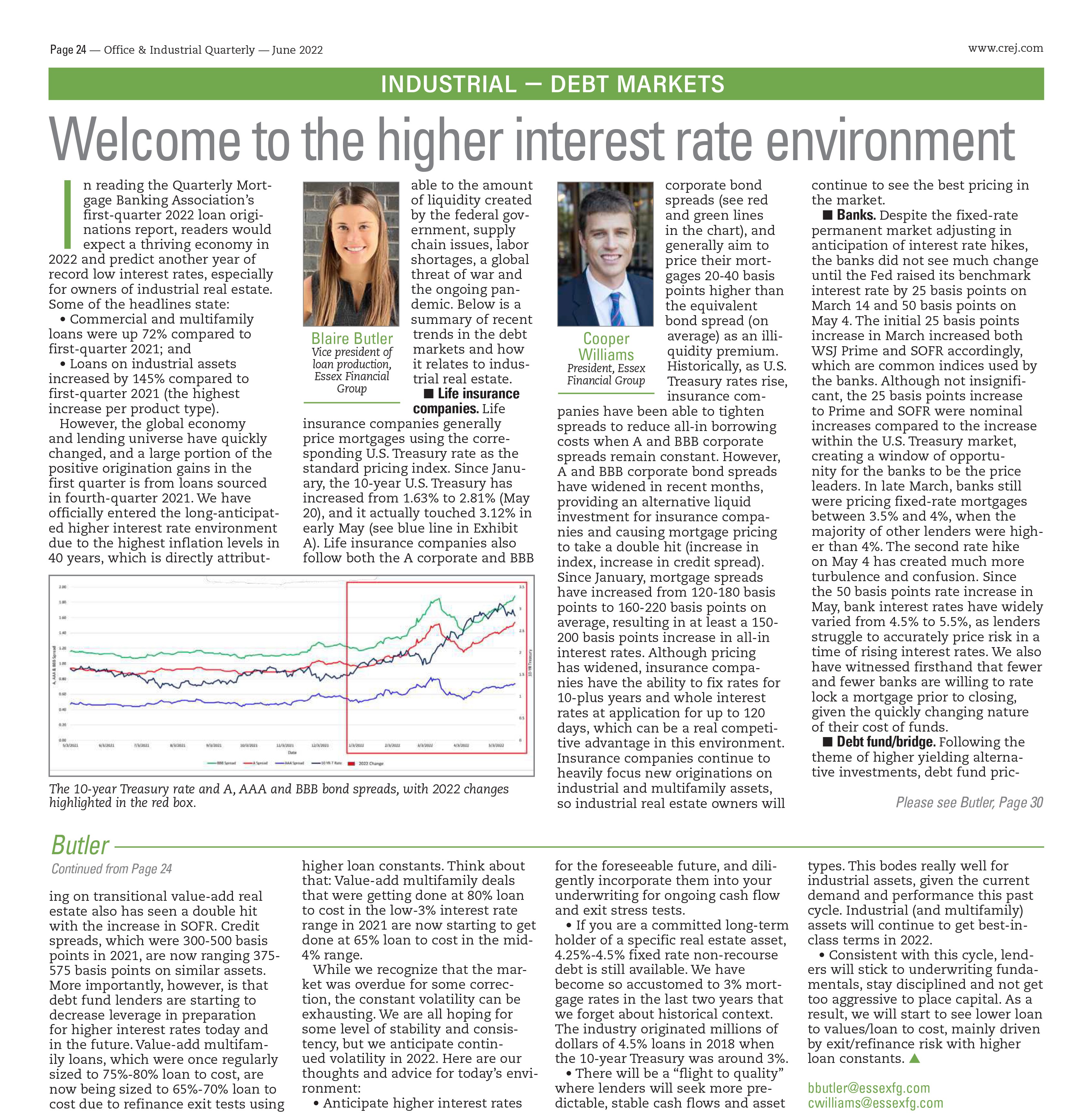In reading the Quarterly Mortgage
Banking Association’s (MBA) Q1 2022 loan originations report, readers would expect
a thriving economy in 2022 and predict another year of record low interest
rates, especially for owners of industrial real estate. Some of the headline stats:
· Commercial and multifamily loans up 72% compared
to first quarter 2021
· Loans on industrial assets increased by 145% compared
to first quarter 2021 (highest increase per product type)
However, the global economy
and lending universe have quickly changed, and a large portion of the positive
origination gains in Q1 2022 is from loans sourced in Q4 2021. We have officially entered the
long-anticipated, higher interest rate environment due to the highest inflation
levels in 40 years, which is directly attributable to the amount of liquidity
created by the Federal Government, supply chain issues, labor shortages, a
global threat of war, and the on-going pandemic. Below is a summary of recent trends in the
debt markets and how it relates to industrial real estate:
Life Insurance Companies
Life insurance companies
generally price mortgages using the corresponding US treasury rate as the
standard pricing index. Since January
2022, the 10-year US treasury has increased from 1.63% to 2.81% (May 20, 2022),
and it actually touched 3.12% in early May (see blue line in Exhibit A). Life insurance companies also follow both the
A corporate and BBB corporate bond spreads (see red and green lines in Exhibit
A), and generally aim to price their mortgages 20-40 bps higher than the
equivalent bond spread (on average) as an illiquidity premium. Historically, as US treasury rates rise,
insurance companies have been able to tighten spreads to reduce all-in
borrowing costs when A and BBB corporate spreads remain constant. However, A and BBB corporate bond spreads
have widened in recent months, providing an alternative liquid investment for
insurance companies and causing mortgage pricing to take a double hit (increase
in index, increase in credit spread).
Since January 2022, mortgage spreads have increased from 120-180 bps to
160-220 bps on average, resulting in at least a 150-200 bps increase in all-in
interest rates. Although pricing has
widened, insurance companies have the ability to fix rates for 10+ years and
whole interest rates at application for up to 120 days, which can be a real
competitive advantage in this environment.
Insurance companies continue to heavily focus new originations on
industrial and multifamily assets, so industrial real estate owners will
continue to see best pricing in the market.

Banks
Despite the fixed rate
permanent market adjusting in anticipation of interest rate hikes, the banks
did not see much change until the Fed raised its benchmark interest rate by 25
bps on March 14 and 50 bps on May 4. The
initial 25 bps increase in March increased both WSJ Prime and SOFR accordingly,
which are common indices used by the banks.
Although not insignificant, the 25 bps increase to Prime and SOFR were
nominal increases compared to the increase within US treasury market, creating
a window of opportunity for the banks to be the price leaders. In late March, banks were still pricing
fixed-rate mortgages between 3.50-4.00%, when the majority of other lenders
were higher than 4.00%. The second rate
hike on May 4th has created much more turbulence and confusion. Since the 50 bps rate increase in May, bank
interest rates have widely varied from 4.50-5.50%, as lenders struggle to
accurately price risk in a time of rising interest rates. We have also witnessed firsthand that fewer
and fewer banks are willing to rate lock a mortgage prior to closing, given the
quickly changing nature of their cost of funds.
Debt Fund / Bridge
Following the theme of higher
yielding alternative investments, debt fund pricing on transitional value-add
real estate has also seen a double hit with the increase in SOFR. Credit spreads, which were 300-500 bps in
2021, are now ranging 375-575 bps on similar assets. More importantly, however, is that debt fund
lenders are starting to decrease leverage, in preparation for higher interest
rates today and in the future. Value-add
multi-family loans, which were once regularly sized to 75-80% loan-to-cost, are
now being sized to 65-70% loan-to-cost due to refinance exit tests using higher
loan constants. Think about that:
value-add multifamily deals that were getting done at 80% loan-to-cost in the
low-3% interest rate range in 2021 are now starting to get done at 65%
loan-to-cost in the mid-4% range.
While we recognize that the market was overdue for some correction, the constant volatility can be exhausting. We are all hoping for some level of stability and consistency, but we anticipate continued volatility in 2022. Here are our thoughts and advice for today’s environment:
· Anticipated higher interest rates for the foreseeable future, and diligently incorporate them into your underwriting for on-going cash flow and exit stress tests.
· If you are a committed long-term holder of a specific real estate asset, 4.25-4.50% fixed rate non-recourse debt is still available. We have become so accustomed to 3.00% mortgage rates in the last two (2) years that we forget about historical context. The industry originated millions of dollars of 4.50% loans in 2018 when the 10-year treasury was around 3%.
· There will be a “flight to quality” where lenders will seek more predictable, stable cash flows and asset types. This bodes really well for industrial assets, given the current demand and performance this past cycle. Industrial (and multifamily) assets will continue to get best in class terms in 2022.
· Consistent with this cycle, lenders will stick to underwriting fundamentals, stay disciplined, and not get too aggressive to place capital. As a result, we will start to see lower loan-to-values/loan-to-cost, mainly driven by exit/refinance risk with higher loan constants.
